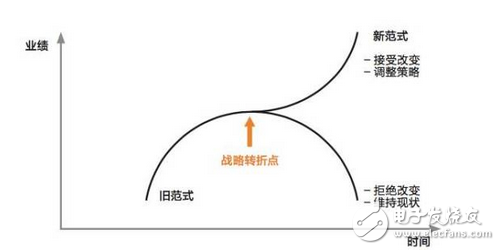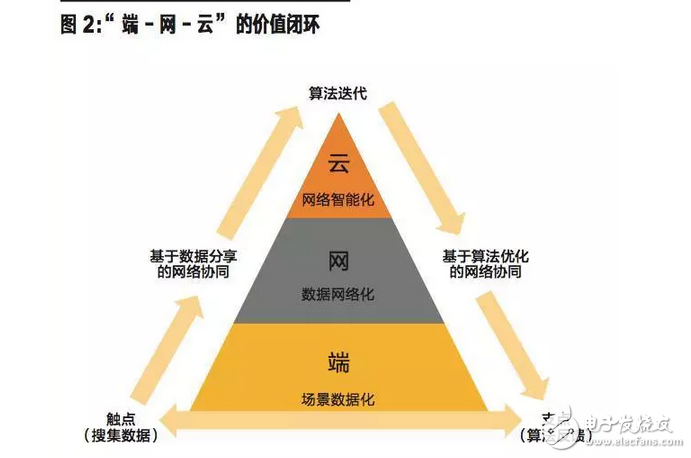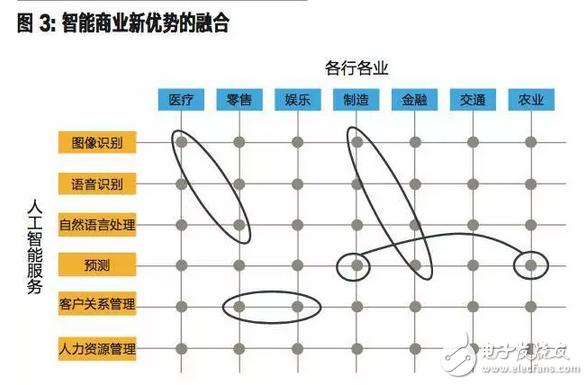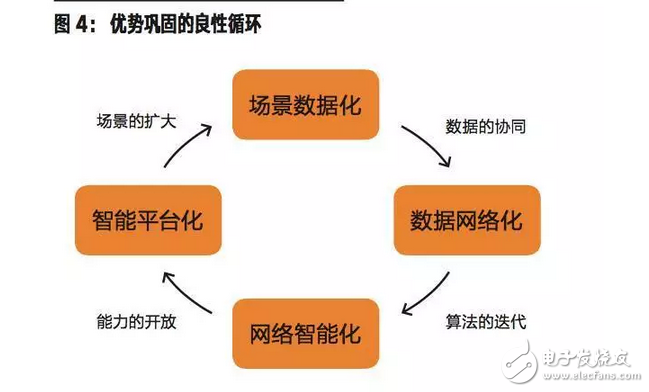On the eve of the era of smart business, the company is facing a watershed: although it seems calm and unpredictable on the surface, the foundation of the company is changing quietly, which means that the company may have the opportunity to rise to a new height, or it may Mark the beginning of the decline.
The crossroads of corporate destiny are called "strategic turning points." At the strategic turning point, it is often not the competitive factors such as cost, price and management that determine the future fate of the enterprise, but the general trend determined by external factors such as technology and user habits.
Figure 1: Strategic turning point

The result of the Internet is that value is redistributed across industries. About 20 years ago, industrial companies such as General Electric, Shell, and Coca-Cola were firmly on the top of the list. However, the top names in today's market capitalization list are almost all IT and DT companies such as Apple, Google, Facebook, and Amazon. This is a strategic turning point, cruel but exciting.
When the massive impact brought by the Internet has not yet come to an end, we will usher in a new wave: a new strategic turning point driven by artificial intelligence. Like the Internet, AI technology will completely change the logic of enterprise value creation and acquisition. Its influence is far-reaching and wide-ranging, thus opening a new era of intelligent business.
Standing on the strategic turning point of smart business, the choice of enterprises in today's choice is related to the fate of the future for a long time. Is it to embrace change, actively change, or to deny change and stick to the rules? Is it proactive to understand the new business paradigm or to be afraid of breaking the existing style of acting? Is it the continuation of the upward growth curve of the enterprise or the downward turning point from now on, withdrawing from regrets and sighs? Although the answers to these questions seem to be obvious, they are difficult to implement.
Intelligent business new ecology
Today's diverse array of smart products and applications are connecting everything across the boundaries of the industry. Therefore, when we discuss the impact of smart commerce, the “industry†is no longer an effective unit of thinking.
In the new business ecosystem with artificial intelligence as the core, “endâ€, “net†and “cloud†span the industry and are the main structural level in the intelligent ecology. They play different functions, and are connected and mutually dependent, which together constitute the cornerstone of the value of the intelligent business era.

end
"End" refers to the contacts and fulcrums that can interact with a business scenario. The interaction here has two meanings: the first is the contact, that is, the source continuously collects the data generated in the business scene; the second is the feedback, which can transmit the constantly updated information and execute the continuously optimized commands. Together with the fulcrum, the interaction loops.
After the emergence of the Internet, the virtual space's website platform, software client and App can also assume the role of information collection: every click, open and time on each page of the user is recorded and becomes a precious data resource. In recent years, the burgeoning and popularization of the Internet of Things has further expanded the scope of “endâ€: not only the interactive interface of the virtual world, but also the visible and tangible physical products can sense the external environment and become information after embedding the digital module. New entrance. For example, sneakers can track runners' movement records to help runners optimize their exercise schedules; industrial systems add digital modules to monitor not only the equipment's operating status, timely maintenance updates, but also accumulated production data for optimization. Production systems provide valuable data.
In addition to perception and data collection, the second important function of “end†is to become the host point for optimization of the entire intelligent ecosystem. This means that the optimization of the system by intelligent algorithms—whether to improve efficiency or optimize the experience—is ultimately reflected in the “endâ€. For example, with data accumulation and algorithm iteration, runners' exercise plans are more and more in line with their individual needs, which is reflected in the exercise recommendations of the App terminal. When the manufacturing equipment collects more and more production data and forms real-time suggestions for improving production efficiency and reducing energy consumption at the algorithm level, it will be automatically executed on the device side. In this way, at the "end" level constitutes a dynamic system of self-renewal.
network
“Net†refers to a business network that includes products, users, and enterprises that are connected by technology modules. Literally, the "net" is easily reminiscent of a communication network system with lines, but the "net" in the intelligent business system is not only reflected in the technical level, its essence is the business ecology - in different business elements Establish a relationship of symbiosis, mutuality and regeneration to achieve network value. After all, discrete "ends" are hard to produce much value if they are not effectively connected and are not related to each other. Only by linking different "ends" together to form a system of mutual sharing and communication can the synergy value of intelligent business be realized.
Network value is first reflected in the superposition and sharing of data. Unlike funds, raw materials and equipment, data is not a consumable resource, so the superposition and sharing of data can often bring about the synergy of “1+1†2â€.
Data overlay refers to the merging of similar or cross-border data to characterize higher-level data patterns. For example, the value of a driver's driving route and speed is limited, but when thousands of drivers share their location and route in real time, they can be superimposed as a “live map†of traffic conditions, providing more benefits to more travelers. reference. Data sharing is the sharing of data collected by one “end†in other relevant “ends†in real time. Information transparency has increased and people can make better decisions.
In addition to the superposition and sharing of data, the value of the network is also reflected in the interaction between the various "ends". Since the smart devices have the ability to "talk" to each other, an "end" action triggers a series of responses from the other "ends" to form an overall linkage. Enterprises can create an integrated experience. For example, in the field of smart homes, people can portray such a picture: when the user opens the smart door lock and enters the room, the sound will play a light and elegant melody, and the light will turn to cool or warm colors. Air conditioners and curtains will be adjusted simultaneously. The whole process is completed in one go, and the ultimate experience is the ability to talk to each other and trigger each other's actions.
In the field of production and supply, the flexible manufacturing system under the concept of Industry 4.0 is connected by computer system to realize automatic connection and adjustment from ordering, design and processing to assembly, inspection and delivery. Since the start-up and adjustment of each production link is automatically triggered, the production efficiency of the flexible manufacturing system can be improved.
Therefore, the essence of the "net" is to achieve data coordination by connecting people, products (objects) and enterprises.
cloud
“Cloud†is a virtual solution that stores, computes, and optimizes “ends†and “netsâ€. Although “net†can superimpose, share and coordinate data, and improve network value, these activities still remain at the level of “data is usedâ€. In other words, the essence of the "net" is to aggregate and comb the fragmented data, but has not yet produced a "chemical reaction." To mine the deep value of data, it must be achieved through the "cloud", the core component of this intelligent business.
If we compare "end" to the intelligent business of the motor nervous system (perceive the external environment, make feedback adjustments), compare the "net" to the circulatory system (transfer oxygen and nutrients to various parts of the body), then "cloud" is a The brain that constantly thinks and commands. It is the soul of the entire intelligent business system.
"Cloud" has two functions: one is basic services, including data storage and computing; the other is core services, namely data intelligence and algorithm optimization. Among them, the latter determines the degree of intelligence of a commercial system. Many commercial systems are not very different on the surface. For example, they all have rich entrances (ends), are committed to information sharing and data collaboration (net), but there is a world of how to dig deep into the value of data. do not. This also directly determines the value of different smart business entities.
Netflix, a well-known streaming website, has unearthed the enormous value of data through the investment in the "cloud" side of the algorithm. Netflix, which is engaged in online video website business, is a natural “endâ€: the behavior track of users on the website, including which videos to choose, which clips to skip, which clips to stay in and even watch repeatedly, can be recorded one by one. Store it up. Through the further overlay of these user group data ("web"), you can analyze the most popular TV drama elements, such as the theme, director and starring. In 2013, Netflix produced the well-received series "House of Cards", which was so successful that it was inseparable from the big data precipitation and preference prediction algorithm ("cloud") behind it. At present, the market value of Netflix has exceeded 300 billion yuan. In contrast, some other video sites can be compared with the traffic, but due to the lack of intelligent "cloud" side, the valuation can only be far behind.
This example shows that "cloud" is an important criterion for distinguishing between true smart business and pseudo-smart business. Today's smart products on the market are exploding in both types and quantities, but if you look at the "end-net-cloud" hierarchy, most smart products only stay at the "end" level - just pre- An interactive module is installed to enable basic interactive functions. Few products can go to the structural level of the "net" to superimpose, share and coordinate data. And the ability to perform algorithm iterations and system optimization in the "cloud" is even rarer. But be aware that the ability of the "cloud" side is precisely the core of smart business.
The “endâ€, “net†and “cloud†of intelligent business rely on each other to form a whole, depicting the big picture of the entire intelligent ecological value structure.
Strategic apocalypse
Before discussing the issue of the source of new advantages for enterprises, it is necessary to first recognize the closed-loop logic of the value of “end-net-cloudâ€.
The closed-loop logic of “end-net-cloud†refers to: In the intelligent business system, “endâ€, “net†and “cloud†rely on each other and are indispensable, which together constitute a closed loop of value circulation.

“End†collects data to provide “fuel†for the entire system; “Net†collaborative data, which amplifies the value of data by overlaying, sharing and connecting; “Cloud†stores and analyzes data, continuously optimizes algorithms, and finally passes “Net†"Return to the "end" to make the interaction in the business scenario more in line with the user's needs, or to improve the efficiency of the entire system. From “end†to “net†to “cloud†and then back to “net†and “endâ€, this forms a virtuous circle of increasing value.
“Endâ€, “net†and “cloud†are indispensable, which means that the advantages of the enterprise in any of the three links can be transformed into new advantages in the intelligent business ecosystem.
First of all, the competitive advantage of traditional industries on the “end†helps enterprises to occupy the “entry†of business scenarios. Whether it is the sales of products vying for the manufacturing industry, or the customer traffic and the number of stores vying for the retail industry, it can be transformed into a “end†with data interaction function through digital means. If the product itself is popular, or if the store has high traffic, it will be able to reach more users and get more valuable data. And this is the foundation of the smart business era.
Secondly, the competitive advantage of the high-tech and Internet industries in the “cloud†helps enterprises to grasp the intelligent “highlandsâ€. These companies usually have a layout in the field of cloud computing and smart technology, and years of immersed in the Internet industry have helped them accumulate large amounts of data. The dual advantages of technology and data will help these companies develop and iterate advanced algorithms, creating incredible advantages in areas such as image recognition, speech recognition and CRM.
In addition, the ecological advantages formed by enterprises in the “network†through cross-border and cooperation also help them to further develop the advantages of network synergy in the era of intelligent business. These companies are good at connecting and inciting external resources and creating value by establishing connections between different network nodes. This is equally important in the era of smart business.

It can be seen that no matter what industry the company is in, competitive advantage (exclusive internal resources) or ecological advantage (inciting external resources), it can find its own foothold in the new intelligent business era. Moreover, the new advantages of these different dimensions will merge and amplify each other.
Consolidate the advantage of the "four parts"
"End-net-cloud" is not only indispensable, but also interlocking and interconnected - to seize the end, it can form a valuable network; enrich the network, it can iterate out advanced algorithms to form intelligent Cloud; updating the algorithm can improve the efficiency and experience of the end.
This means that in the era of intelligent business, the advantage of the enterprise is fluid: it can be transferred from one link to another, and through continuous transmission, a virtuous circle of consolidation and expansion of advantages is formed.
There are four specific steps involved in this process—scenario data, data networking, network intelligence, and intelligent platforming. There are no fixed starting points for these four steps, because the cycle can start at any one (the company has an advantage). Of course, it has no end, because the consolidation of advantages is an ongoing process.

Scene data
"Scene data" is a business that is good at acquiring and precipitating data in different business scenarios.
"Scenario Data" first requires companies to define and create scenarios. On the user side, many companies today pay great attention to “preempting the entranceâ€, occupying traffic through high-quality interactive products and reaching more users. There are also many companies that increase the “contacts†that interact with users by establishing and nurturing communities, improving online and offline channels, and user experience full-cycle management. These activities are all defining new business scenarios. On the supply side, real-time recording and updating of the data of each node in the supply chain (such as inventory quantity and location) and the status of each part of the production equipment is equivalent to creating a new information space and defining a new scene. At the organizational end, companies systematically data the behavior, relationships, and performance of employees to predict their turnover intentions, promotion prospects, etc., which is a new scenario for defining a talent-organization interaction.
The systematic collection and precipitation of data at any end is the first step in bringing the value of “contactâ€.
Data networking
"Data networkization" means that enterprises should be good at using the resources of the business ecosystem to coordinate data.
Data collaboration is important because the value of data generated by a single “end†is extremely limited. For most companies, due to the number of users, business data types and other restrictions, the data is often fragmented - can not fully depict the user's portrait, and can not superimpose representative group characteristics. Therefore, it is difficult to be directly applied to the iteration of intelligent algorithms.
The synergistic value brought by the heterogeneous data combination is huge. Imagine that individual child education data may not be of much value, but if combined with children's DNA, family background, and other educational data for their peers, there will be many insights and business value.
The synergy of “1+1†2†can be achieved by establishing a mechanism for information superposition, sharing and convergence between the user group, the enterprise group and the product group. This requires companies to not only do valuable products (thus generating valuable data), but also to build sustainable reciprocal and mutually committed relationships with stakeholders. This test is the ecological construction ability of enterprises to incite external resources.
Network intelligence
"Network intelligence" is the efficient operation of the entire system through technology and algorithms.
"Network intelligence" essentially forms a system-optimized solution through the analysis of data, which in turn intervenes in the behavior of the system. Optimized solutions can be tailored to the user experience—providing customized products that better match the user's needs; either for supply efficiency—optimizing inventory distribution, reducing storage costs, or for organizational management—predicting former employees. Take precautions in advance.
"Network intelligence" is a dynamic process. In the past, insights about how to improve user experience and system efficiency often existed in the team's internal knowledge system. The formation and acquisition of insight relied on experience and understanding, mostly static and fragmented. "Network intelligence" is to migrate insights to the cloud. By absorbing and integrating data from different groups, the algorithm has the basis for continuous self-renewal. This requires companies to continually validate and iterate algorithms to build a high wall of competitive advantage.
Intelligent platforming
"Intelligent platforming" is to open up the capabilities of the cloud (including data, computing, algorithms, etc.) to third parties.
On the one hand, sharing the remaining cloud capabilities with the outside can increase the company's ability to liquidate. The accumulated funds can be invested in new businesses and capabilities to consolidate the company's strengths.
On the other hand, by opening up the cloud, companies can extend their reach to a wider range of business scenarios, thus expanding the reach of the “endâ€. For example, Rookie Logistics opens the “Logistics Cloud†service to third-party logistics companies, which can obtain more enterprise logistics data, which is a valuable resource that cannot be obtained in its original business.
"Intelligent platforming" completes the value transfer from "cloud" to "end". In this way, a complete closed loop from "scenario dataization", "data networking", "network intelligence" to "smart platformization" is formed.
The prelude to the era of intelligent business is slowly opening. For enterprises, not only must they grasp the time window, choose the appropriate development direction, but also actively adjust and adapt to the new business paradigm, and in the process explore the mechanism to establish and consolidate the new advantages of the enterprise.
Exhaust Fan,Wall Ventilation Fan,Louver Exhaust Fan,Commercial Exhaust Fan
Guangdong Shunde Langzhi Trading CO., Ltd , https://www.langzhielectrical.com